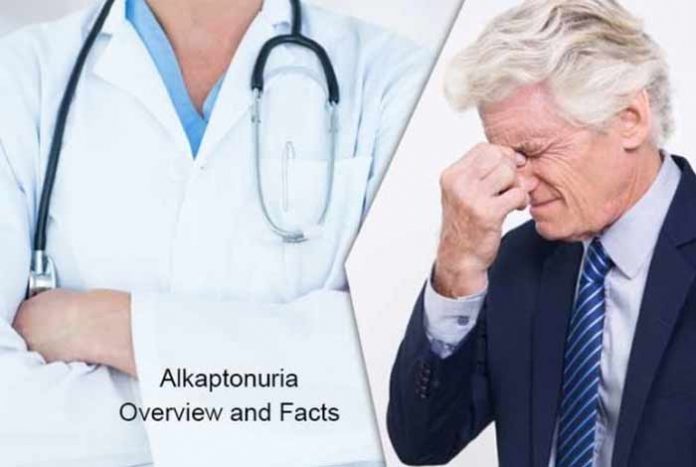
Overview and Facts
Alkaptonuria is a genetic disorder that is quite rare. It causes homogentisic acid to build up in your body. This leads to discoloration of the urine. Urine becomes dark blue or black when exposed to air, this is why it is also called black urine disease. It also causes bones and cartilage to become brittle and discolored. Ochronosis – building up of dark pigment in connective tissue like skin and cartilage – is also a feature of this disorder. While having alkaptonuria, the body is unable to produce enough homogentisic dioxygenase (HGD). HGD is used in breaking down of homogentisic acid. When there is not enough HGD, homogentisic acid builds up. This pigmentation generally starts after the age of 30. Starting in early adulthood, people with alkaptonuria develop arthritis in their joints and spine. Other characteristic features may include kidney stones and heart problems. Alkaptonuria is a part of group of conditions, known as inborn errors of metabolism.
This condition is rare, which affects one in a million people across the globe. It is commonly found in certain areas of Slovakia (that is it affects 1 in every 19,000 people) and in the Dominican Republic.
Types and Symptoms of Alkaptonuria
It is sometimes asymptomatic i.e. without symptoms. Symptoms become more obvious as one ages. Urine becomes dark brown or black after getting exposed to air. Osteoarthritis may also set in when you hit your 20s or 30s. Someone, who is having alkaptonuria, may feel stiffness and pain in the back. Some other symptoms are listed below:
- Dark spots in the white portion of eye with no interference with vision.
- Discoloration of skin particularly around sweat glands
- Presence of black earwax
- Kidney stones, prostate stones or heart failure
- Thickening of ear cartilage
- Arthritis
- Dark colored sweat
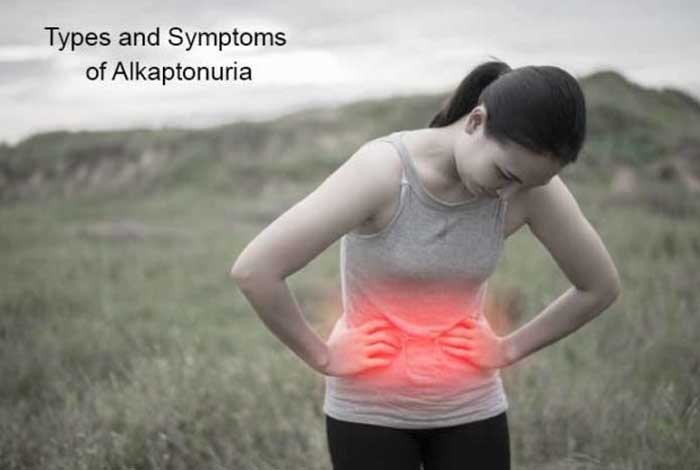
Alkaptonuria may lead to heart problems. When homogentisic acid builds up, it hardens heart valves. This results in the valves not being able to close properly that leads to valve disorders. Blood vessels also harden, which may cause high blood pressure. In addition to accumulation in cartilage, homogentisic acid may accumulate in tendons and ligaments and sometimes, even in bone. With passage of time, affected tissue becomes brittle or weak. Affected individuals develop abnormalities like inflammation of the tendons or thickening of Achilles tendons. Affected tendons may be prone to rupturing. During infancy, diapers may get stained black, but sometimes the symptom goes unnoticed.
Risk Factors of Alkaptonuria
- General: If a person has a family history of alkaptonuria, he/she is more susceptible to have the disease. It is a genetic disorder inherited by a person in autosomal recessive pattern. This means mutation must be inherited from both the affected parents for the disease to manifest itself.
- Ethnicity: Although it is not a very common disorder, yet the rates of prevalence is higher in certain populations. It is more common in certain areas of Slovakia.
- If One Parent is a Carrier: If only one parent is a carrier, there is only 50% chance of transferring the mutated gene to the child, and hence, no chance of actually inheriting the disease. If both the parents are carriers, there is 25% chance that the child will inherit the disease.
Do I have Alkaptonuria?
You may have alkaptonuria if:
- Your urine turns dark brown or black when exposed to air.
- If you are in your 20s or 30s and experience joint pain, it is early onset of osteoarthritis.
- Chronic stiffness and pain in lower back or joints
If you simply experience pain in joints, it may be due to arthritis. However, if other symptoms persist like darkening of urine then these are signs of alkaptonuria. Sometimes darkening of urine may also be caused due to dehydration. Inflammatory condition of liver may also result in urine color change. This is due to the occurrence of hepatitis. So, it is best to consult a doctor for proper diagnosis of this genetic disorder.
Causes and Prevention of Alkaptonuria
1. Causes of Alkaptonuria:
Mutations in Homogentisic dioxygenase (HGD) gene causes alkaptonuria. For the gene to be passed over to the child, both parents must have the mutated gene. This is called autosomal recessive inheritance – both parents carry the gene, but do not have any symptom of the disease. The HGD gene makes an enzyme, known as homogentisate oxidase. This enzyme breaks down two amino acids, viz., phenylalanine and tyrosine that are protein-building enzymes. The enzyme’s role is impaired by mutations in HGD. Homogentisic acid, produced when phenylalanine and tyrosine are broken down, gets accumulated in the connective tissues. This causes darkening of cartilage and skin.
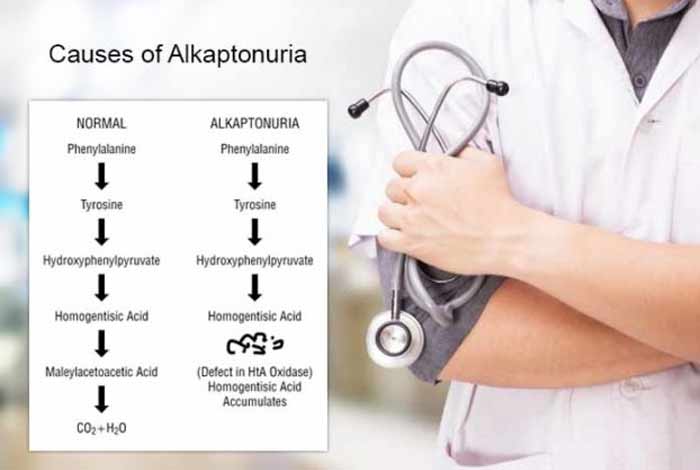
2. Prevention of Alkaptonuria:
Observation of dark-colored urine in infants should be checked. Genetic counseling for known cases may help. Prenatal tests must be carried out to identify the condition in the womb itself. For patients with alkaptonuria, regular monitoring and following the advice of doctors can help in early diagnosis and treatment of the condition.
It may help to follow healthy routine with a balanced diet and restricting intake of high protein foods. Regular exercise may be carried out as per doctors’ advice.

Diagnosis and Tests of Alkaptonuria
Alkaptonuria is diagnosed on the basis of symptoms of joint pain and skin discoloration. Doctors confirm the disease by studying the family history of the persons with alkaptonuria, examining the skin cells under a microscope, testing urine for the presence of homogentisic acid. High urinary level of homogentisic acid is defined as greater than 4-8 gm a day. Diagnostic tests can be performed on a blood sample using paper chromatography and thin layer chromatography.
If the specific mutation that causes alkaptonuria in a family is known, then DNA of the individual can be tested for the presence of that particular mutation. Mass spectroscopy can also be used to identify high levels of homogentisic acid. X-ray techniques may be employed to identify complications like degeneration or fusion of vertebrae in the lower back. Chest X-rays is used to detect hardening of heart valves.
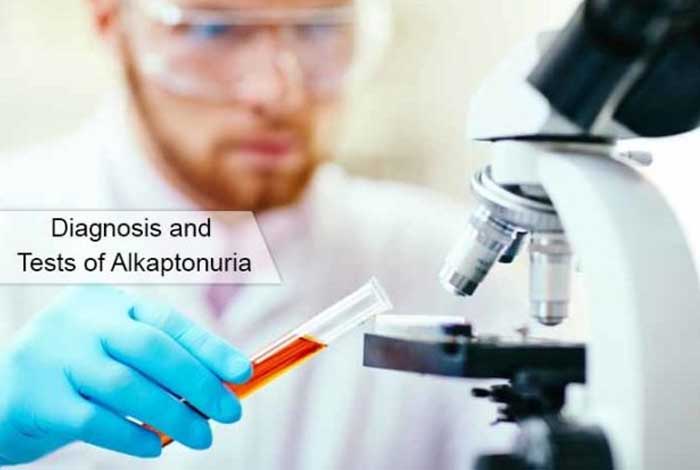
Treatment and Care of Alkaptonuria
1. Treatment of Alkaptonuria:
Unfortunately, no specific treatment is available for alkaptonuria. However, a low-protein diet is recommended. Other recommendations include giving large doses of ascorbic acid or vitamin C. This slows down the accumulation of homogentisic acid in the cartilage and connective tissues. Long-term use of vitamin C may not prove to be very effective. Other treatments are mostly based on preventing other conditions like arthritis, kidney stones and heart diseases.
Doctors may prescribe over-the-counter drugs for issues like joint pain. To maintain strength and flexibility in joints, physical therapy is recommended. Research suggests that around 50% of people with alkaptonuria need a surgery of shoulder, knee or hip by the age of 50-60. Surgeries may be required to treat kidney and prostate stones. Researchers are currently studying the use of a drug, called nitisinone for the treatment of Alkaptonuria.

2. Care for People with Alkaptonuria:
Getting the disease diagnosed timely and getting it treated is the key. This disorder may be present along with multiple comorbidities. This makes the treatment all the more challenging. Care of the patient with alkaptonuria is complex. There are no prescribed guidelines for the management of the patient and his/her conditions.
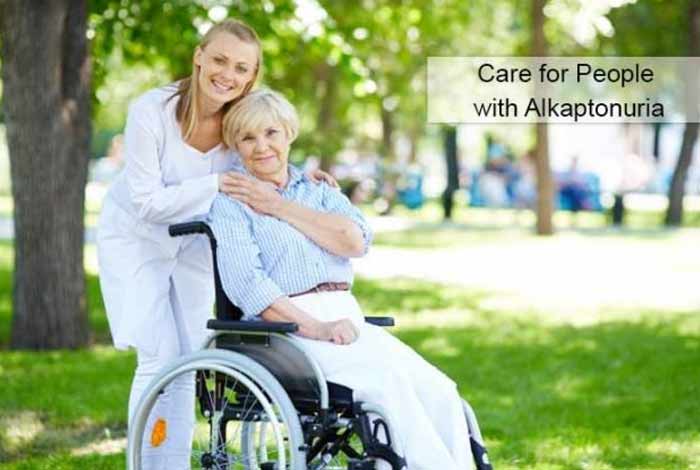
OTC Medications and Self-Management Methods for Alkaptonuria
1. OTC Medications Methods for Alkaptonuria:
Patients with arthritis may take non-steroidal, anti-inflammatory drugs (NSAIDs) or acetaminophen to relieve pain and inflammation. Commonly used over-the-counter NSAIDs include ibuprofen (Advil or Motrin) and Naproxen sodium (Aleve). Higher strength formulations of these drugs are available only with a prescription. Commonly prescribed NSAIDs include diclofenac. Ketoprofen and nabumetone.
2. Self -Management Methods for Alkaptonuria:
Eat a low-protein diet. Consume large amounts of ascorbic acid or vitamin C for slowing down the accumulation of homogentisic acid in the cartilage. Patients can also go for a physical therapy to maintain flexibility and strength of muscles. Physiotherapy is also necessary to manage joint pain resulting from alkaptonuria. Non-weight exercises like swimming are also suggested. Patients should avoid putting pressure on spine and joints. So, alkaptonuria patients should not take part in high impact sports.

Natural Ways to Treat Alkaptonuria
There is no known established methodology in natural medicines and Ayurveda to treat this rare genetic disorder. Herbs like Drakshadi kashayam and Punarnavadi kashayam are known to be helpful to some extent. These medicinal herbs support the excretion of metabolic waste from the body. Treatment of alkaptonuria is generally focused on relieving symptoms like arthritis, kidney stones and heart diseases.
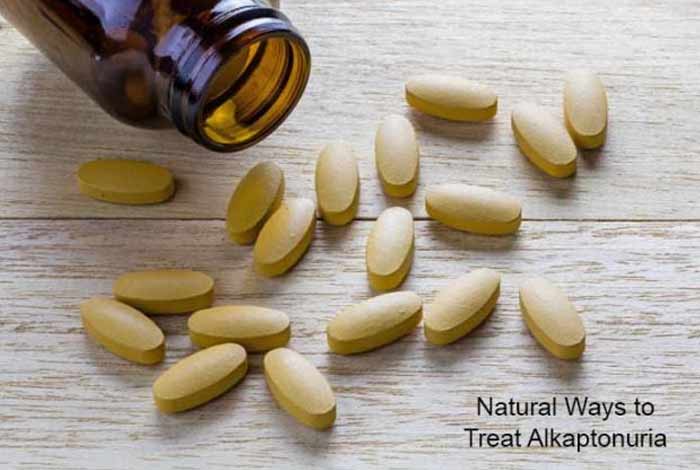
Health Tip by Expert
Regular monitoring and following the advice of the doctor is the key to effectively manage alkaptonuria.






